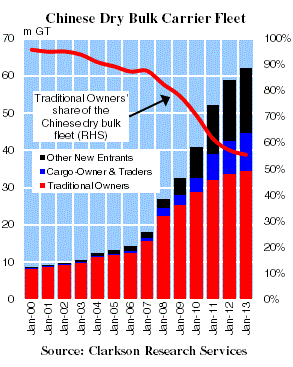A Market Reshuffle In Bulker Ownership?
Over the last decade, China’s dry bulk imports have rocketed to 1.3bn tonnes in 2013. Such has been the development of China’s involvement in dry bulk trade that concepts such as the Baltic Dry Index are becoming common currency amongst laymen. Many non-traditional companies and investors have been showing interest in getting involved in shipping, and consequently, the nature of ownership of the Chinese dry bulk fleet is changing.
Farewell to Traditional Owners
Traditionally, the Chinese shipping industry has been dominated by a few, mostly state-owned players, such as COSCO. The data on the Graph of the Month defines ‘traditional owners’ as those which entered into the business of dry bulk shipowning prior to 2000. As the graph shows, their fleet share began to drift downwards from 2003, when China’s dry bulk import boom began to gather steam. However, since the global economic crisis, the encroachment of non-traditional owners has accelerated. Traditional owners now represent 55% of the Chinese bulker fleet (in GT terms), down from 80% pre-crisis.
Of course, this is not to suggest that the large state-owned players have become marginalised: far from it. The ranking of the largest Chinese dry bulk ownership groups has hardly changed in the past ten years, bar the merger of Sinotrans and CSC in March 2009. The 3 largest ownership groups remain centrally-managed by the State Owned Assets Supervision Commission, meaning that the state retains a major role in ownership.
Cargo Fightback
Since the downturn, which has brought a large-scale reduction in vessel asset values, many cargo interests have decided to invest in shipping, as a way to safeguard against any increase in transport costs. These companies, including both state-owned new-entrants like CITIC Pacific, and private cargo interests in iron ore, coal and soybeans, now have a 17% share of the Chinese bulk fleet.
As the graph shows, the new entrants to dry bulk shipping have not been restricted merely to cargo interests. 17m GT of the bulker fleet is now accounted for by ships owned by other types of company. These include companies with prior experience in other logistics areas, like HNA Group or Centrans Ocean, investment companies like Minsheng or Huarong, and even Jiangsu Huaxi Corp., the investment vehicle of Huaxi village. The so-called “richest village in China” (each inhabitant’s stake in the village’s listed corporation is worth around $130,000 and the village contains the 52nd tallest building in the world) now owns a total of 12 ships.
Encouraging Signs
So, why the new entrants? On one hand, shipowning could help cargo owners to reduce freight rate risk and secure supply chains. At the same time, asset prices are attractively low, while other Chinese asset classes (e.g. equities) have performed badly. Traditional owners, including SOEs, retain a large share of dry bulk ownership, and this is likely to remain the case. However, given the stated aim of the new Chinese leadership to reduce the influence of SOEs, and recent ordering patterns, it would not be surprising to see the diversification of Chinese dry bulk ownership continue.
HEADLINES
- Do shipping markets want Biden or Trump for the win?
- All 18 crew safe after fire on Japanese-owned tanker off Singapore
- Singapore launching $44m co-investment initiative for maritime tech start-ups
- Cosco debuts Global Shipping Industry Chain Cooperation Initiative
- US warns of more shipping sanctions
- China continues seaport consolidation as Dalian offer goes unconditional
